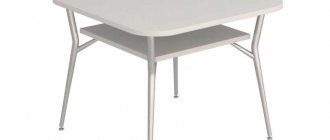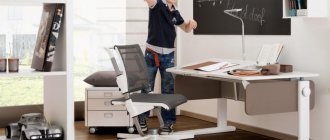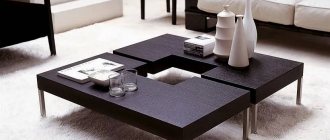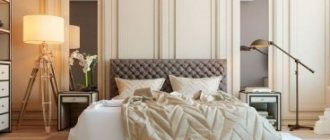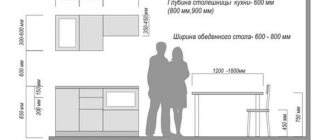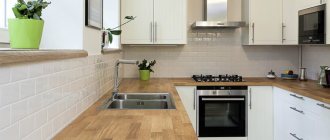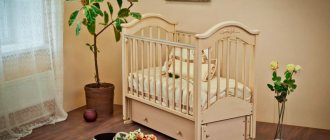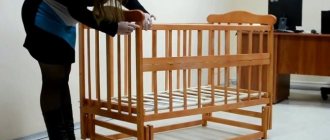Parents approach arranging a sleeping place for a child very responsibly, but in the process of choosing a bed they often reach a dead end. The most difficult question is deciding on the size of the bed. In this case, the following points are important:
- The size of the bed and the size of the sleeping place are different concepts;
- The bed must be suitable for the child according to his physical characteristics;
- The bed should not “eat up” all the usable space in the children’s room;
- The current age of the child and the period for which the bed will be used are important.
Now let's look at these nuances in more detail.
What are the sizes of children's beds?
Children's furniture cannot increase in size as children grow older.
For different ages, there are standards that should be followed when choosing children's furniture. There are models:
- for infants (these can be cribs or small beds that are used up to three years);
- for children over three years old;
- for teenagers.
Each group has its own characteristics that should be taken into account. It depends on how comfortable the baby sleeps.
Transformers
The dimensions of the transformable crib depend on the number of functional elements that were used in the design. This model is preferred by those parents who want to avoid the expense of purchasing several sets of furniture, each of which corresponds to the age of the child. By reinstalling the elements of the bed, parents modify the bed in accordance with current needs. Thus, you can change the design to the size of a regular children's bed for a teenage child. The main characteristic that affects the future applicability of the product is the overall dimensions of the base on which all additional elements are installed.
Standard sizes
Standard sized cribs have a bunk bed. Adult models are suitable for schoolchildren and teenagers, the main thing is that they are made from safe materials. The length of such products is 190 cm, width - 90 cm. If it is assumed that the bed will be used at student age, then you should pay attention to two-meter options.
Models measuring 70 x 160 cm are suitable for children from 5 to 12 years old. When buying such a bed, you should keep in mind that after a few years it will have to be replaced. Some manufacturers offer sliding products whose width increases to 80 cm. This option is ideal for an active child.
Restless children should not buy a bed with a height of more than 40 cm from the floor when sleeping.
The height of the sunbeds varies from 30 to 60 cm. The main rule is that they should be comfortable to sit on. If for some reason you purchased a low model, it is easy to make it taller with a thick mattress.
Non-standard products
Furniture factories produce not only standard children's beds, but also completely unusual ones. They fit perfectly into modern designs and are often equipped with additional functions. Some of the most popular:
- Cribs for twins with dimensions of 130 x 125 cm - they are relevant until 4-5 years, after which two single beds or one bunk model are purchased.
- Car beds, as well as products in the shape of a castle, ship, or rocket, serve not only as a sleeping place, but also as an indispensable decoration for a child’s room. The sizes in this case depend on the age of the baby.
- Transformers with a chest of drawers are the most functional options, combining the properties of a bed and furniture for storing things; their width is standard.
- Models longer than 210 cm are not available in mass production and are made to order. They are not suitable for children, but are suitable for tall teenagers.
Transformable models are combined not only with a chest of drawers or a wardrobe. Additional elements can be a changing table, a desk. Modern manufacturers equip beds for newborns with lights, carousel toys, and rattle holders. Any additions inevitably affect the cost of the finished product.
A custom size model requires a matching mattress. If it is not included in the kit, you will have to place an order for custom tailoring.
For newborns
According to generally accepted standards, sleeping places of the following sizes are suitable for children: length 110-120 cm, width 60 cm, side height up to 95 cm. The lower part of the crib is adjustable by age: the upper level is for newborns, the lower level is for a child from 3 years old. Manufacturers offer several options for the little ones. First of all, this is a cradle that can be used for up to 6 months. Floor and hanging options usually have dimensions of 0.4 x 0.8 m. Secondly, this is a box. The dimensions of the multifunctional model for children start from 0.9 x 1.1 m and are convenient not only for sleeping, but also for playing.
Popular bed models for three children, useful additions
There is also a classic bed model. The domestic standard size is 1.2 x 0.6, sometimes options are 1.40 x 0.7 m. Foreign models are slightly different in size: 1.25 x 0.68 m and 1.7 x 0.6 m. Type of children's furniture - bedside. A product with a removable wall is usually not produced larger than 1 x 0.5 m.
Classic models
They are most in demand on the market, as they have a number of advantages:
- Made from natural wood;
- The position of the berth is adjustable in height;
- Domestic manufacturers have a low cost;
- Service life up to 3-4 years;
- The bed size is standard 120x60cm or 140x70cm, which greatly simplifies the selection of bedding sets.
Classic beds are presented in several modifications, which have different principles of “swinging” the child:
— The pendulum is practical and thoughtful. The swinging mechanism allows the mother to quickly put the baby to bed without straining her back during the swing. The design principle is simple, the frame itself is attached to the base using a special mechanism with bearings, so when swinging the base remains motionless. According to the principle of direction, swings are divided into three subtypes:
- Universal - swings in any direction;
- Transverse - “left-right”;
- Longitudinal - “back and forth”.
Regardless of the selected subtype, the presence of locking latches is mandatory to lock the pendulum mechanism.
- About runners. At the bottom of the structure, instead of legs, there are two arches that rock the crib. Some modifications provide a mechanism for fixing these arches by installing supports or wheels;
- On legs or wheels. A classic design without a swinging mechanism, but usually equipped with under-bed drawers, saving money and space when purchasing a chest of drawers or wardrobe on the ground.
It is worth noting the disadvantages of classic beds, including:
- Large bed for newborns. Since the baby is not yet accustomed to a lot of free space around him, he may feel uncomfortable. Many mothers are purchasing a baby cocoon for the first time or covering the area under the hips with rolled up towels or blankets;
- Dimensions and weight. Unfortunately, despite many advantages, such cribs take up a lot of space, so you should consider this point before purchasing.
Cradles
This type is very popular among parents who want to create comfortable conditions for themselves and their kids. This model can be equipped with a bow with toys, a visor, wheels and other elements, but the main feature is a manual or automatic motion sickness system.
Typically, these models are designed for babies up to 8-12 months, so their length does not exceed 85-95 cm and the width is 50 cm. When the baby is 8-12 months old, the crib will need to be changed to another.
The disadvantage of such models is that they do not have the necessary stability. This must be taken into account during operation.
A simple cradle that can independently rock a newborn, supporting a weight of up to 20 kg.
Rocking beds
They appeared because many children get used to falling asleep when rocked. Sometimes it is difficult to hold a growing and growing baby in your arms; a rocking bed is an excellent solution. There are various mechanisms for motion sickness, but the most popular option is beds on runners, in which the entire structure moves with the legs.
Transformers
As the name suggests, these are beds that can be transformed into other furniture or the shape and size of the bed can be changed. This type is gradually beginning to replace classic models due to its high functionality and practicality advantages:
- The cradle can grow with the baby and, unlike classic models, the transformer has undergone a small shelf, convenient for newborns;
- Long service life up to 7-12 years;
- Variety of shapes;
- The modifications include options with all the necessary furniture, which can also be transformed.
The disadvantage can also be seen in the dimensions, because when the transformer “grows” to its maximum size, it will take up no less space than the classic version, but in the “child” size they are not bulky.
Attached models
Overlay frames are an ideal solution for nursing mothers - the baby will always be nearby. The structure is installed or mounted next to the parents’ bed. Its second part is protected by a wooden edge. This product will easily fit in the smallest room, and the baby can sleep in the crib for up to 1 year.
The width of the crib is 40-50 cm and the length is 85-95 cm. A child can only sleep up to 1 year, so you will have to buy new furniture.
Is the baby no longer sleeping in the additional model? Turn it into a comfortable chair, and if you put a chair here, you get a table!
Beds for two
Parents of twins or twins are very often forced to buy two separate beds for each of the children, since such amenities are not available everywhere or not all rooms are comfortable.
When children grow up to 3-4 years old, you can take care of a bunk bed, which will help you save space and fit perfectly into the children's room.
How to teach a child to sleep separately
Co-sleeping helps to establish a bond with the baby, but over time it can cause discomfort for parents, so it is important to help the baby learn to sleep separately. How comfortable is it for everyone to teach a child to sleep in his own crib?
Pros and cons of co-sleeping
Pediatricians and psychologists have different views on co-sleeping between children and their parents. Experts highlight the following advantages [1]:
- Improving the functioning of the nervous system and reducing stress.
After birth, the child finds himself in unusual conditions. The only thing that gives him a feeling of security is closeness with his mother and father. Sleeping together (next to each other, but not in the same bed) with parents helps the child get used to new conditions and create psychological comfort. - Establishing lactation.
A child who sleeps next to his mother eats on demand. This promotes the production of milk necessary for the normal development of the baby. Therefore, if the mother also feeds the baby at night, more milk is produced. - Improving the sleep of the child and parents.
The baby sleeps better if he falls asleep with his parents. If something wakes him up during the night, his parents can react quickly.
The disadvantages of co-sleeping include the following:
- Nervous tension and disruption of intimacy between spouses.
Some parents cannot fully relax and get enough sleep. Also, sleeping together with a child can alienate spouses. - Difficulty learning to sleep in your own room.
Children who sleep with their parents from an early age have a harder time moving to a separate room and sleeping separately than those who sleep in a separate crib from birth.
Until what age can you sleep together?
The time when the child should sleep separately is determined by the parents themselves. And if mom and dad decide that they want the little one to sleep in his own separate room, then this is the right decision for the family. The optimal age for gradually weaning off co-sleeping is one and a half years. At this time, the child gradually stops waking up at night to drink or eat, which can help him quickly get used to separate sleep.
It is better to temporarily leave the baby to sleep with mom and dad if:
- the child was born premature;
- the mother has unstable lactation;
- the baby has poor sleep;
- during teething and illness;
- when adapting to kindergarten.
- if the child is expected to live in the same room with older children.
What to do to make your child want to sleep separately
Child under one year old
It happens that the option of sleeping together is not suitable for all family members. The child becomes more active, takes up more space, preventing parents from getting enough sleep and being alone. The process is complicated by the baby’s habit of falling asleep on his mother’s chest, so the work may take a long time.
Recommendations:
- Come up with a “ritual” for going to bed. This could be a bath, a massage or a lullaby.
- Try to put your child to bed at the same time every day, with a maximum deviation of 5–10 minutes.
- Move the crib close to the adult bed and lower the side to create a shared sleeping area. You should not use the crib as a playpen - the child should associate it exclusively with a place to sleep.
- After feeding, always transfer the baby to his crib. When the baby gets used to waking up alone and does not cry, you can try moving the crib to his room.
- Don’t worry if the process takes longer—you can teach your baby to sleep separately only gradually.
From 0 to 3 years
According to current standards, a little person from birth to three years old is provided with a crib with a sleeping area of 110-120 cm by 60 cm. The sides are made no higher than 85-95 cm. The position of the mattress at the bottom is about 30 cm from the floor level, the top - 50 cm. The lower part of the product is adjustable in terms of installation height: the upper level is suitable for children up to 1.5 years old, the lower level is suitable for children over three years old.
Sometimes they buy cribs with the dimensions of the bed itself being 40 by 80 cm - they are completely stuffed with soft material, there are floor models and models suspended from the ceiling. The upper part of the crib is decorated with a fabric canopy, the lower part with a lambrequin. The cradle acts as a kind of cocoon in which the baby is comfortable, because it is protected from all sides, and is used for a maximum of six months.
A rocking bed is designed for children who fall asleep only if they are rocked - usually this design is a bunk with rails along which the entire object moves from side to side. There are also options for programming the pendulum: using the remote control you set the time and amplitude of the oscillations.
Cradles, rocking chairs for babies from 0 to 3 years
Beds in the form of cribs and rocking chairs are available in various variations.
Their distinctive features are:
- safety;
- comfort of the child's stay;
- compact overall dimensions;
- the same motion sickness of the child upon awakening;
- mobility.
The disadvantage of using the product is the short shelf life of cribs - up to 6 months, rocking chairs - up to 3 years. The cradles are made on the basis of pendulum mechanisms.
Types of products are divided according to the principle of action:
- longitudinal pendulum, simulating swinging on the hands;
- transverse pendulum, when the bed swings from side to side;
- universal, combining longitudinal and transverse mechanism (optional).
Rocking beds are arranged using the same principle, which are installed on guides located on the legs of the product. There are 2 options for the location of the guides: longitudinal and transverse.
A rocking chair differs from a cradle in its larger dimensions. Over time, special clamps can be installed on the runners to block the swinging of the product or wheels.
On wheels
The most common models measuring 120 x 60 cm are designed for children under three years of age. They also have height adjustment thanks to a movable bottom. Thanks to the removable side rail, which can be folded or completely removed, the child can climb into the bed independently. The legs of these models are stable or with runners to rock the child.
Over time, when your baby no longer needs to be held, you can attach grab bars to prevent him from tipping over. Additionally, many of these models have drawers for clothing, bedding, or toys located at the bottom or on the side.
Beds on wheels are convenient because they can be easily moved around the room. This is a great option for those babies who sleep poorly and parents have to get up often. The only difference is that wheels are attached to the legs.
Playpen bed
Children's playpens become popular from 6 months to 2 years, when leaving the baby alone is dangerous.
The advantages of the product are:
- durability and convenience;
- functionality, as the beds can be transformed into a changing table, cradle, desk, bedside table;
- safety;
- lower height adjustable;
- mobility.
Boxes vary in shape: round, square, rectangular, oval.
According to the age limit of the child, the following types of playpens are produced:
- wooden structures of standard sizes for children from 0 to 5 years;
- rectangular wooden transformers intended for children from 0 to 12 years old;
- a box bed, covered with fabric, designed for a period of 0 to 3 years;
- The folding travel playpen can be used from 0 to 1.5 years.
Ergonomic playpen beds
If you like to travel or plan to often leave your child with grandma, a playpen is the best choice. This model has two levels: a hanging cradle for a baby up to 6-7 months and a hard bottom on which a baby can sleep up to 1.5-2 years.
The dimensions of the product are 120x60, the height of the model reaches 80 cm, this is enough to prevent the child from falling out of bed. And if you decide to buy a new crib for your child, you can use the playpen as a play area or a place to store toys. Another advantage of playpens is their compactness and quick assembly. They can be folded or unfolded in less than 3 minutes.
Choosing the size of a bed for a newborn is a complex process, during which you need to take into account the age of the child, the budget for furniture and the size of the room in which it will be installed.
What you need to know about mattress sizes
Choosing the right mattress size is an important condition for healthy rest. After all, if it is even slightly large, then “bumps” will form on the bed, creating discomfort that may not be felt at first, but will make itself felt in the form of headaches and back problems. If, on the contrary, it is small, then when used it will slide along the base of the bed, which is also inconvenient.
Before purchasing a mattress, you must carefully and accurately measure the bed.
By size, mattresses are divided into single, one-and-a-half, double and children's.
When purchasing, keep in mind that American manufacturers indicate dimensions in inches, and domestic ones in centimeters.
If the mattress for the bed is not suitable, then you will not be able to achieve a comfortable sleep.
For children from 3 years old
The dimensions of a cot for children from 3 to 6 years old should be approximately 60-80 by 140-150 cm. The optimal height is 30 cm. At 3-4 years old, the protective sides are removed. For a child of this age, you can choose non-standard figured models and transformable beds.
Modular
Beds for children over three years old differ in their assembly. Previously, cabinet furniture was in demand. It was a solid structure, not attached to the wall. If there were different compartments and lockers, they were all fastened together.
Currently, modular furniture is increasingly used for interiors. It can consist of several elements, each of which represents a completely separate block. Such a product, made of high-quality materials, is expensive.
Modular models of cribs usually consist of 1-2 beds, lockers, bedside tables, a play area or an office. If desired, some bricks can be removed or something added.
Transformable bed
This is a complete furniture set, which includes a crib, chest of drawers and linen drawers. As the child grows, the chest of drawers can be used as an independent piece of furniture: a bedside table, coffee table, nightstand.
This crib can be designed for an older child up to 10-12 years old. The length of the bed can vary from 140 to 180 cm, and the width is usually 60 cm.
For children, it is better to buy wooden beds (made of solid wood) rather than beds made of plywood or chipboard. This is especially true for children under 12 years of age, which is associated with their increased activity.
Standard singles
Connoisseurs of classics will definitely like the standard single bed. It has a sleeping place, there are no additional functional elements on it, except for the sides. Such a model will cost less than its competitors, since its manufacture requires much less material. The optimal choice for a child living in his own room.
It’s easy for a parent who has carpentry skills to make it with their own hands. Such a homemade crib for a 3-year-old child will look no worse than a store-bought one.
Thematic
If you want to please your baby with something fabulous, then you should pay attention to thematic patterns. Such a piece of furniture will develop a child’s imagination and give him many magical hours of play. These products are usually a specific item. Recently, a sleeping house for children over 3 years old has become very popular. The roof has a sloping shape and there is often an attic. It is recommended to buy a canopy and soft sides in the kit. The baby will be comfortable there, and during daytime sleep you will be able to shade the sun's rays.
A bed with a side for a child over 3 years old is a machine or special equipment. All products have bright and eye-catching colors. Children's beds for girls from 3 years old can be decorated in the form of a stroller, a water lily, or a fairy-tale house. Manufacturers are able to satisfy the desire of any child.
Roll-out
For older children, choose beds with a pull-out bunk bed. During the day it hides in a niche. Most often, such products have two beds, sometimes even three. Each of them extends beyond the top, forming a staircase. Such original cribs are not very high, it is almost impossible to fall out of them, but they rarely come with bumpers. Convenient for a large family.
It will be easy for a child to roll out such a bed without the help of an adult. The main thing is that the retractable mechanism works flawlessly. To do this, you should definitely try to open an establishment in the store several times.
When should you change your child's bed?
Sleeping places for children need periodic updating, and therefore sooner or later the child will need another bed. Furniture must be replaced in the following cases:
- The child grows up
This process is natural and inevitable, and therefore, from the moment the baby is born, it is necessary to plan to replace the bed in a few years. As children grow and develop, the dimensions of the furniture change according to the following principles:
- From 3 years.
For a young child, it is necessary to increase the length of the bed to 140-145 cm, while the height of the children's bed from the floor also changes by at least 30 cm upward. - 7-10 years.
For a primary school student, a length of 160 cm and a width of at least 80 cm will be required. The height can be left the same or increased by 10-20 cm if you plan to place drawers for linen or toys under the bed. - Children 10 years and older.
Schoolchildren and teenagers will be provided with comfort by a bed with a minimum size of 90x180 cm and a height of 50 cm. Adult single beds also have the same dimensions, so your child can choose an option in any model range. - There has been a sudden change in the child's height or weight
In this case, a change of bed will be required before moving to the next age stage. Selecting furniture based on standard criteria can be quite risky, so you should focus on individual parameters: if the child stretches out quickly, you need to add at least 30-35 cm to his height, and from 15 cm to his width.
- The child became uncomfortable
Inconvenience can be caused not only by changes in weight and height, but also by subjective reasons - because of the high sides he is unable to climb into the bed on his own, the low headboard does not allow him to get comfortable, or due to too active games in the room he often hits parts of furniture. In this case, it is important to select a model as soon as possible, based on the individual needs of the child, otherwise poor sleep quality will affect his well-being.
- The bed is damaged
If breaks and cracks appear on the body or base, parts of the bed become loose or fall off, replacement is necessary as soon as possible, and primarily for safety reasons.
For teenagers
A teenager needs an almost “adult” bed, with a bed size of 70-90 cm by 180-190 cm, up to 50 cm in height. Imported designs are wider - about 100 cm. There are also sliding options that change as they grow older - from 120 to 180 cm. The model is convenient because it does not require replacement after a couple of years - the crib is made as durable as possible, from high-quality materials.
A mattress for a “growing” bed does not always need to be completely replaced - individual options are created using one or two fragments of the same texture as the main product.
Bed sizes for preschoolers and schoolchildren
A crib for a child 4-7 years old has the following dimensions: sleeping area 60 by 140 cm, height from the ground - about 30 cm. After three to four years, the railings disappear. The student bed is a little larger: 80 by 160 cm, height from the floor level 40 cm. There are other parameters: 75 by 150 cm. Many of these products are painted in bright colors, stylized as boats, cars, decorated with lace trim, a canopy of delicate colors, equipped with a drawer that can serve not only as storage, but also as an additional surface for board games.
Children of any age love to jump on the bed, so that the furniture does not break too quickly, it is recommended to buy a structure with the most durable base.
Loft bed
The sleeping place for this model is located above the floor at a height of 1 to 1.5 meters, and below it is an area for games, sports or a table for studying. This crib is equipped with sides on the sides to prevent the child from falling while sleeping. It is worth noting that such a bed is very large, but will allow the child to organize his own personal corner in the room.
The loft bed is a compact two-story structure with a sleeping area on the second floor.
Transformers
Transformable beds are very convenient to use in small apartments. Some models can turn into a table or other piece of furniture. There are baby cribs with sides that can be used from birth to school age. As the baby grows, parents remove the high sides and buy a larger mattress. High-quality furniture of this type can be used for up to 10 years.
Single
It is better for school-age children to purchase bed models. They can be no smaller in size than adult beds, but differ in the requirements for the quality of materials used and design.
The standard size of a single bed is 100 cm wide and 190 cm long.
Bunk
This model is ideal for a small room where two children aged 7 years and older live. Takes up less space than single structures. Most two-tier products have a size of 90 x 190 cm - this is the standard. Due to decorative and additional functional elements, the length sometimes increases to 210 cm. The height usually does not exceed 180 cm. This parameter should be selected based on the height of the ceilings in the room.
Recommendations for organizing a sleeping place for a child
The bed is the place where a child spends most of his time in the first years of his life. This is the cradle of peace and the world of his fabulous dreams. It is here that the baby watches his first dreams while his body grows and gains strength. The psycho-emotional state of the child, the correct development of his spine and the health of the musculoskeletal system as a whole largely depend on the correct organization of the sleeping place. That is why it is so important to choose the right children's orthopedic mattress, bed, pillow and other bedding.
Sizes of different types of children's beds
The crib in which a newborn sleeps is standard size 97 * 55cm, the height varies depending on the model and is adjustable. Cribs are neatly designed and small in size, but after six months, a standard child grows out of a similar crib and needs a new one. A crib is suitable for a small apartment and for those parents who are willing to spend money on children's furniture and replace it in a timely manner. It is convenient to use a lullaby in the parents' room in the first six months of a baby's life, when you want to maintain the connection between mother and child for as long as possible.
The attached model will become an extension of the parent's bed, on which the baby will sit comfortably. The size of the side bed is standard 90 * 50cm, which is slightly smaller than the classic model
It is important that the attached model has the ability to adjust the bottom to “match” the height of the parent’s bed, but it is better to choose in advance the model that is ideal for an adult. Another important point is the presence of elements for attaching a crib to an adult, which will ensure the safety of the child while sleeping
A classic bed for newborns has standard Russian dimensions of 120 * 90 cm, in Europe these dimensions are 5 cm larger - 125 * 95 cm. The classic among beds is distinguished by the presence of a swinging mechanism - a pendulum (it can be longitudinal and transverse) or its absence, therefore the bed has removable legs and wheels or runners.
The classic model, as a rule, has two lower positions, a slatted bottom, and the ability to lower the front side; some models have an additional drawer at the bottom.
Transforming the crib will be a good investment in the child’s future - it will be useful for a newborn and will last up to 7-8 years (until the child outgrows the product). The transforming bed has a built-in chest of drawers and a changing table, standard size 140 * 70cm, sleeping place for a child 90 * 60cm with the possibility of increasing it. After the initial appearance, the product becomes small for an older child, the chest of drawers with the changing table is removed, and the bed is expanded.
There are models of children's furniture for twins or twins, which are a product with parameters of 130 * 125 cm. A bed for children will last about 3 years, so you will need to replace it with a spacious two-tier model or separate products for each child.
In addition, there are cots of different sizes, which are a playpen at the bottom and a sleeping area at the top. The sleeping area is small and will be used by a child until one year of age, after which the child is unlikely to fit.
Beds of non-standard sizes are unique in their design, for example, round and oval models with dimensions of 78 * 76 * 81 cm (length * width * height), which “grow” in length up to 128 cm for children of non-standard sizes. Standard ones are mostly increased in length, which allows the use of an expensive model for up to 5 years.
It is worth noting that the parameter 120 * 60 cm, used to indicate the size of a classic-shaped crib, indicates the size of the bed; the crib itself can be larger than 6-10 cm due to the presence of additional elements. - side walls, sides. This applies not only to this model, but also to some other types of children's furniture.
Is the bed width 160 or 180?
No registered user is viewing this page.
Design of curtains for the kitchen in 2022: tips for choosing and current models
6 smart options for designing a kitchen in a one-room apartment
Work triangle in the kitchen: 6 solutions for different layouts
- Construction and repair
- Foundation
- Roof
- Walls
- Window
- Doors and partitions
- Ceiling
- Balconies and loggias
- Internal structures
- Floor
- Water supply and sewerage
- Heating
- Ventilation and air conditioning
- Gas and energy supply
- Lighting
- Plumbing equipment
- Security and home automation
- Baths, saunas, swimming pools
- Construction Materials
- Decoration Materials
- Tools
- Technique
- Laws and finance
- TechnoNIKOL
- Design and decor
- Apartment
- Bedroom
- Kitchen
- Dining room
- Living room
- Bathroom, toilet
- Hallway
- Children's
- Attic
- Small rooms
- Workplace
- Wardrobe
- Library
- Decoration
- Furniture
- Accessories
- Vacation home
- Landscape
- Redevelopment
- Catalog of houses
- Magazine
- News
- Events
- about the project
- Advertising on the website
- Advertising in a magazine
- Terms of use
- Contacts
- about the project
- Advertising on the website
- Advertising in a magazine
- Terms of use
- Advertising on the website
- Advertising in a magazine
- Terms of use
- Contacts
What to consider when choosing a children's bed
It is known that a child’s productivity largely depends on the quality of sleep. Without adequate sleep, academic and athletic performance will decline significantly. And the crib, well, is a durable structure that adapts to the individual and is able to maintain the correct position of the spine during sleep.
For both the developing child and the teenager, it is very important that the room has a bed that captivates them, sparks curiosity, pleasure and imagination. There are so many options on the market, from bunk beds to beds with built-in desks, and you need to know what criteria you need to meet in order to purchase your desired piece of furniture.
you need to know what size a crib should be, what material it should be made of, what additional features it should have, or how to determine if it poses a risk of injury to your baby.
Safety
A safe product is one that cannot cause injury when interacting with it. The bed should not have gaps between the sides: a curious child can stick a finger into it, pinching painfully. Any roughness is also unacceptable - splinters are a very unpleasant thing for a baby’s thin skin. All metal fasteners are disguised with wooden and plastic plugs.
The distance between the crib rods is no more than six cm. The sides are removable and fixed. The bed must be sufficiently stable: the narrower and higher the model, the greater the likelihood of it tipping over. Any sharp edges or various traumatic decorations are prohibited.
Used materials
The quality of the materials from which cribs are made is an important factor in the durability, stability, strength and appearance of the crib. The most recommended materials for making a bed frame are wood and iron, materials that not only last a long time, but are also very beautiful.
- A solid wood bed is recommended due to its stability over time and its heavy weight. These beds are beautiful, warm, and can be made in a variety of shapes and sizes. Beech, oak, ash, walnut or pine are some examples of materials used to make cribs.
- A metal bed is not inferior in strength to a wooden one. Beds with a metal frame are very durable, do not creak and have a good weight.
- A bed made of chipboard has a much lower price, which allows it to be used in a shorter time. You can choose a combination of solid wood with chipboard or metal with chipboard to ensure that your bed lasts long enough. Chipboard is easy to work with and is recommended only for decorative purposes, not for resisting elements.
- A plastic bed is not as durable as wood or metal, but it comes in a variety of shapes and colors, is very easy to maintain and clean, and is safe because it is round in shape and provides security.
Child's age
Age is another aspect to consider when choosing a good bed. The age, build and weight of the child are mainly taken into account. The age of the child affects the aesthetic appearance of the bed, technical characteristics and safety features.
- The aesthetic aspect is very important, because in adolescence there will not be an ideal bed in the form of a racing car, a princess stroller or a Minnie Mouse. But if you're choosing a bed for an older child, you might want to look for a solid wood bed with storage for books and gadgets, or a bed with a desk to combine business with pleasure.
- The weight that the bed can support is selected depending on the age and actual weight of the child. Choosing the wrong bed can affect your baby's comfort. In other words, it should be taken into account that a small child is more likely to “jump” in bed and expose him to additional stress compared to his actual weight.
- Safety devices include those side guards that protect a sleeping child from falling out of bed or from being hit during sleep. In the case of a bunk or hanging bed, there should be bumpers, removable side walls or ladders to protect the child and increase his safety.
Preschoolers often identify with fairy tale characters and have strong early interests, and this should be taken into account when choosing a bed. Now there is such bedroom furniture in the form of cars, boats, and for girls - four-poster beds in which real princesses sleep.
Types of cribs
Biały pokój dla dziewczynki
- A transformable bed is a bed that can be used for a child up to 4 years old by simply unfolding it. The child will be able to use it for a long time. The duration of use of such a bed depends entirely on the height and weight of the child.
- You can choose a simple nativity scene of the desired shape and size; the range of models is very wide. The choice of crib should be based on the child's height and weight, as well as the extent and rate at which he will develop in the future.
- A bunk bed is the ideal solution for two children who need to share the same room. A bunk bed is effective because it saves space in the bedroom.
- A hanging crib is another way to save space in a small bedroom: bunk beds with one or two bunks that have several useful areas, such as a school area with shelves and drawers for books and notebooks, or even play areas for children.
- Loft beds are also models equipped with additional elements that will bring a lot of pleasure to children of kindergarten and primary school age. These are models with stairs and structures (children's bed) or with fairy-tale towers and slides (children's beds).
Bed linen size chart
Bed sets come in several types, with features such as the number of items and their individual sizes.
Sometimes it's very easy to get confused.
Moreover, the possibility of choosing imported products brings additional difficulties, since different countries adhere to their own standards.
Bed linen sizes
All bedding sets, with the exception of those sewn to individual orders, can be classified into one of 5 standard types.
Table
| Set size | Duvet cover | Sheet | Pillowcases |
| One-and-a-half (one-and-a-half-sleeping) | from 143x210 cm to 160x230 cm | from 145x200 cm | 50x70 cm 70x70 cm |
| Double (Russian standard) | from 175x210 cm to 180x220 cm | from 175x210 cm | 50x70 cm 70x70 cm |
| Double (Euro standard) | from 200x220 cm to 215x220 cm | from 200x215 cm | 50x70 cm 70x70 cm |
| King size (Euro Maxi) | from 220x240 cm to 240x260 cm | from 220x240 cm | 50x70 cm 70x70 cm |
| Family (two duvet covers) | from 143x210 cm to 160x230 cm | from 175x210 cm to 260x270 cm | 50x70 cm 70x70 cm |
Types and standards
Single and one-and-a-half beds
- 1 duvet cover,
- 1 sheet,
- 1 or 2 pillowcases depending on the model.
As the name suggests, the set is designed for one, but today traditional single sets are becoming increasingly rare.
1 to 5 bedroom sets are very popular, which are suitable not only for one person, but also for a married couple who sleeps in the same bed.
Double and Euro
A double set features larger duvet covers and sheets, and can include two or four pillowcases and one duvet cover.
The set is suitable for both singles and married couples.
Family
Family models are equipped with 2 one-and-a-half duvet covers.
Designed for married couples who prefer to cover themselves with different blankets.
Euro Maxi
The size of the duvet cover in this set is 220x240 cm, and the size of the sheet can reach 260x260 cm.
Pillowcases in Euro maxi sets come in two standards: 70x70 and 50x70 and are usually supplied in the amount of 4 pieces.
Classification
The classification of bed linen by size in Russia and in Europe differs not only in numbers: European linen is marked with symbols in English.
- Single bed linen can be designated as “1-bed” or “single”.
- Double – “2-bed”, “full” or “double”.
- "Queen" is the equivalent of the Russian "Euro".
- One-and-a-half sets are designated as “1.5-bed” and “extra-long single”.
- You can also sometimes find “king-size” sets, which are essentially “three-bedroom”.
- The designation “baby bed” is typical for linen for the cribs of small children and newborns.
Children's bedding
When choosing bedding for babies, it is important to consider :
- Quality of materials;
- Coloring (an important parameter from the point of view of psychologists that can influence the quality of a child’s sleep);
- Bed linen size
size table
| Set | Duvet cover | Sheet | Pillowcases |
| In a cot (for babies) | from 110x140 cm to 125x150 cm | from 100x140 cm to 130x160 cm | from 25x30 cm to 40x60 cm |
| Teenage (one-and-a-half-sleeper) | from 143x210 cm to 160x230 cm | from 145x200 cm | standard 50x70 cm |
First of all, you need to purchase a mattress, based on the size of which, choose the linen itself.
Mattresses of three standards are available for children and teenagers:
- For newborns .
- younger children .
- For teenagers .
For teenagers and young children, the size of the sheet is most often not critical.
In addition to the sheet, the bedding set for babies includes a duvet cover and one pillowcase. Their size should not exceed the size of the blanket and pillow by more than 4 centimeters.
This is considered to be the optimal reserve:
- on the one hand, it leaves no room for the bedding to fidget inside,
- on the other hand, such linen, even after shrinking as a result of the first washes, will not be “tight” for a blanket and pillow.
Tips for choosing
When choosing bed linen from both Russian and foreign manufacturers, it is necessary not only to take into account the difference in the sizes of each type, but also the configuration.
Pillowcases
For example, one-and-a-half sets are designed for one person, but they can be used by two people, so in such a set there are often two pillowcases.
size table
| Pillowcase size | Pillow size |
| Standard square 70×70 cm | from 68x68 cm to 70x70 cm |
| Standard rectangular 50×70 cm | from 48x68 cm to 50x70 cm |
Duvet cover
As for the duvet cover, it is usually selected to match the size of the existing blanket.
Crib materials
Many types, but not all are safe. There can be several of them in one design. They must be natural. The child will chew the grill or rim. You need to find out what kind of paint it is (water-based or not).
- Wood is an excellent, harmless and safe option. These cribs are well ventilated. The material has hypoallergenic properties and retains heat. Solid beech, cherry, and unpainted oak are some of the best and most resilient species.
- Metal is also a harmless material. Very strong and durable. There is a drawback: it's cold. Also keep in mind that hitting metal and hitting wood are different things. This crib needs soft sides.
- Chipboard (chipboard). They are economical and durable. The characteristics are similar to wood. However, resins are added during manufacturing, which can negatively affect the baby’s health. Check the availability of a quality certificate for the product.
- Plastic. Its advantage is a lightweight cradle. This is a durable material, but the most dangerous. Toxic substances are added during the production process. This applies to inattentive manufacturers.
Think carefully before purchasing such a model.
Cot cradle up to what age
Now I was browsing online stores for children. I had never thought about a cradle, but then I saw it and wanted it. Although they managed with their son without her. Who has a cradle? Is it convenient to use? Until what age do babies sleep in them? Is it worth the money spent? Damn, they are all so beautiful.
Along with the usual stationary cribs, in children's goods stores you can find cozy and soft cradles for newborns. It is believed that the baby will be more comfortable in such a cradle, because its shape resembles mother’s favorite tummy. Also, thanks to the design of the cradle, it is easy to rock the baby to sleep, without any need to hold him in your arms. Thinking about which cradle to choose?
? Read the tips in our article!
Beautiful examples
The Ukrainian model EllipseBed 7 in 1, according to parents, has no disadvantages. Bed made of alder or beech. It has an original design, the walls are decorated with hearts. Available in different colors, from white to dark. The bottom can have three positions, and there is also a rocking mechanism and wheels with stoppers. Transforms from a crib to a children's table. On bunks with a diameter of 72x72 cm you can place the baby in any direction.
Unusual multifunctional model Sweet Baby Delizia Avorio with a pendulum made in Italy
It attracts attention with its laconic design, made of natural wood. Diameter 75x75 cm, when transformed it stretches to 125 cm
There is a pendulum mechanism, 3 lower positions. There are rollers that are loosely attached and do not have a stopper. Simultaneous use of wheels and pendulum is not possible. The cradle is poorly polished.
This multi-functional turquoise bed made from New Zealand pine isn't cheap, but it will last for generations. High-quality wood processing and material resistance to deformation will delight young parents.
How to choose the optimal mattress height
The list of characteristics that must be taken into account when choosing includes:
- bed size.
The most comfortable option is to place the mattress at the level of your knees. Most beds are equipped with small sides, the purpose of which is to prevent the product from sliding off. The optimal height of the mattress also depends on the height of these sides. With a recess of less than 5 cm, the height of the product should be no more than 20 cm, with 6–10 cm - a maximum of 22 cm, with more than 11 cm - no less than 23 cm; - age and complexion of a person
. It should be borne in mind that a thin mattress will instantly sag under the weight of an adult. A mattress that is too high will be ineffective in terms of orthopedic properties. If the product is intended for a child or a person with poor posture or back pain, then incorrectly selected height and rigidity can cause health problems.
Rating of the best manufacturers
On the Internet you can find many ratings of crib manufacturers, most often they include the following:
- national teams: Krasnaya Zvezda, Lel, SKV, Brichiola, Antel, Papaloni;
- foreign: Pali, Wundermoebel, Bambolina, Valle.
A crib, changing table, bedside table, and separately purchased baby care products are much more expensive than a convertible bed that combines all of these items at once. It is worth noting that domestic manufacturers have long learned to make high-quality furniture, so their models very often lead the charts and are the highest in terms of price-quality ratio.
The versatility of a convertible bed will undoubtedly increase the comfort of a child's bedroom, making efficient use of space. Thanks to the wide range of models presented, it is easy to find exactly what suits your child.
The main advantages during operation are the lightness and quietness of moving parts.
What to do if you need a custom size mattress?
There are many cases when standard mattress sizes are not suitable. For example, if a person wants a bed in the shape of a circle, with curves, etc.
An orthopedic mattress will give you healthier sleep
Then you will have to make this piece of furniture to order. Many bed stores offer this service. You can contact a factory or a furniture workshop. Many companies do this kind of work. When ordering, not only the size of the product is specified, but also the filling, upholstery, spring stiffness and other points.
Mattresses made from a block of independent springs are beginning to lose sales to more modern models.
How to choose
Durability and safety
You should pay special attention to the quality of assembly of the cradle, check for the absence of sharp corners, chips and removable parts . The bed frame should be strong and well support the newborn's spine, as well as facilitate safe rocking.
Dimensions
Most models have standard length dimensions, but the width can vary, depending on the brand and the designer’s ideas. It is better for parents to give preference to a wide cradle so that the baby’s movements are not constrained.
The difference between orthopedic mattress models and regular ones
Comfort and ergonomics are one of the most important criteria when choosing a mattress. You need to choose a quality product that allows you to restore your strength as much as possible during rest. An orthopedic mattress can cope better with this task.
Proper and quality sleep will definitely have a positive effect on your health.
- Firstly, this product was developed by specialists in the field of medicine, and, therefore, is manufactured using special technologies that allow for disease prevention. It is also used in complex treatment as prescribed by a doctor.
The type of filler will determine how hard it will be.
- Secondly, this mattress is much stiffer than a regular one. But this is not bad, as you might think, but on the contrary, it is better for the body. Because thanks to this very rigidity, the load on the musculoskeletal system is distributed evenly during sleep. A regular mattress only supports the hips and shoulders, which does not allow the muscles to fully relax.
An orthopedic mattress is always an order of magnitude more expensive than a regular one.
The price of an orthopedic product, naturally, is an order of magnitude different from a regular one. But nothing can replace healthy sleep. It's worth it in the end.
A properly selected mattress can serve you faithfully for a very long time.
Norms and various variations
Oxygen enters organs and soft tissues with blood, which flows under a certain pressure (arterial/BP). This leads to vibrations of the walls of the arteries, emptying and filling of the veins. Under the influence of blood pressure, red blood cells or erythrocytes forcefully “break through” the thinnest blood vessels or capillaries. At the same time, they overcome a certain resistance. Substances that carry electric current or electrolytes undergo a similar process. This creates a pulse that is felt throughout our body and in every vessel of our body. On the other hand, a pulse wave can be considered as a wave of movement of the walls of blood vessels under a certain pressure. The number of these waves usually corresponds to the number of heartbeats.

